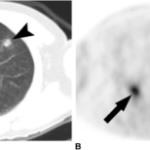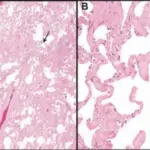Pulmonary Langerhans cell histiocytosis is a rare syndrome of unidentified etiology occurring mostly in young smokers, characterized by focal collections of Langerhans cells that cause scarring, alveolar damage, and airway obstruction.
What is the Pathology of Pulmonary Langerhans Cell Histiocytosis?
The pathology of pulmonary langerhans cell histiocytosis is:
-Etiology: The cause of pulmonary langerhans cell histiocytosis is believed to be exposure to cigarette smoke.
-Genes involved: Unknown.
-Pathogenesis: The sequence of events that lead to pulmonary Langerhans cell histiocytosis is not clearly understood.
-Histology: The histology associated with pulmonary langerhans cell histiocytosis shows poorly-defined nodules distributed in peribronchiolar location. Nodules are sclerosing containing langerhans cells and inflammatory cells. Also shows fibrosis with concomitant cystic change.
How does Pulmonary Langerhans Cell Histiocytosis Present?
Patients with pulmonary Langerhans cell histiocytosis typically have no gender prevalence present at age range of 20 to 40 years. The symptoms, features, and clinical findings associated with pulmonary Langerhans cell histiocytosis include cough, dyspnoea, weight loss, and fever. CT scan shows the presence of ill-defined stellate nodules and thin-walled cysts.
How is Pulmonary Langerhans Cell Histiocytosis Diagnosed?
Pulmonary langerhans cell histiocytosis is diagnosed through laboratory tests- CBC and ESR, Radiographic Tests- chest x-rays, CT scan. Biopsy may be useful.
How is Pulmonary Langerhans Cell Histiocytosis Treated?
Pulmonary langerhans cell histiocytosis is treated through smoking cessation, medical care- oxygen therapy, treatment for pulmonary infections, and bronchodilator therapy. Surgical therapy such as lung transplantation may be needed.
What is the Prognosis of Pulmonary Langerhans Cell Histiocytosis?
The prognosis of pulmonary Langerhans cell histiocytosis is fair and it is related to cessation of smoking.



